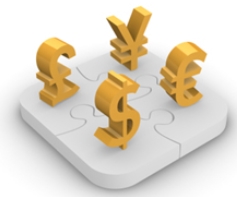Economies around the world have different currencies, and they reflect the way an economy is performing. Stronger economies are associated with stronger currencies, while a weaker currency is usually the result of an economy that is performing poorly. Directly buying or selling a currency is not possible, as this can only be done against other currency. For that reason, currencies are grouped in pairs, and Forex trading means buying or selling a currency pair. If the currency pair moves in the right direction, a profit is made; and if not, the trading account suffers a loss. Currency pairs are of different types, based on the currencies in their componence. A currency pair therefore reflects the differences between the two economies it represents. Let’s take for example the GBP/USD pair. The two currencies that form this pair are the Great Britain pound (GBP) and the US dollar. They represent two of the largest economies in the world: those of the United Kingdom and the United States, and so it means that the currency pair moves based on the difference between the United States’ and the United Kingdom’s economies. In other words, if the US economy performs better over a specific period of time, such as a quarter or a year, the GBP/USD should normally move to the downside. Shorting the pair based on the differences between the two economies it represents means trading on fundamental reasons. Fundamental analysis is not the only type that makes a currency pair move, so it is not enough to only look at economic differences between the two economies. Other factors such as technical analysis, supply and demand, etc., also influence currency pairs.
Different Currency Pairs
There are different currency pairs that form the so-called dashboard, and they are grouped into different categories. The one factor that matters the most in grouping currency pairs is the all-important US dollar. The US dollar is the world’s reserve currency, and it represents the one currency the entire financial system as we know it functions on. Everything in the financial system is based on the dollar, and therefore it represents the one fixed element that allows currency pairs to be grouped.
Profit Split: up to 90%
Accounts: $25k-$200k
Challenge: 2-phase, no time limit
Welcome Bonus
$25
Min Deposit: $100
Welcome Bonus
10% up to $5,000
Min Deposit: $100
Welcome Bonus
100% Deposit Bonus
Min Deposit: €10
Welcome Bonus
$30
Min Deposit: $5
Welcome Bonus
100%
Min Deposit: $0
Welcome Bonus
100%
Min Deposit: $50
Welcome Bonus
$50 Free
Min Deposit: $500
Welcome Bonus
$100
Min Deposit: $5
Bonus
NONE
Min Deposit: $100
* T&Cs apply to each of the offers. Click “Trade” for more details
Currency Pairs That Have the US Dollar in Their Componence
All the currency pairs that have the US dollar in their componence are called majors. A major pair is considered more important than other currency pairs for multiple reasons. One of the reasons is the fact that major pairs are more liquid. A liquid currency pair is one that is traded heavily, and there are no shortages of either supply nor demand at any one moment in time. If you think of the fact that the US dollar is present in these pairs, and the fact that it is the world’s reserve currency, it is only logical that these pairs are the most liquid ones. Clearings are made in dollars, and therefore volatility on major pairs is higher than on other currency pairs. Such major pairs are the EUR/USD, GBP/USD, AUD/USD, USD/JPY, USD/CHF, USD/CAD, and NZD/USD. If you look at the economies these pairs represent, you’ll find the Eurozone, the United Kingdom, Australian, Japanese, Swiss, Canadian and New Zealand economies. In other words, all the major economies in the world are paired with the United States economy because of the central role of the US dollar.

Out of the currency pairs listed above, the EUR/USD is the most liquid one, and the most popular one among retail Forex traders. Because of that, the spread (the difference between the ask and bid price) on the EUR/USD pair is the smallest one of all the majors. In some cases, brokers offer the EUR/USD pair at 0.1 pips spread, which is virtually almost no spread at all. However, not all major currency pairs have the same liquidity. At the opposite extreme, the USD/CAD is the least liquid major currency pair. This means that at times it is difficult to sell or buy the USD/CAD pair in large volumes, because there is simply not enough demand or offer on the pair. To counter this, Forex brokers increase the spread for the pair during these times. The time of the trading day when there is little liquidity is between the North American session and the start of the Asian one. That is the moment when the daily candle changes for most Forex brokers, and spreads are extremely wide.
Currency Pairs That Do Not Have the US Dollar in Their Componence
Any other currency pair that does not have the US dollar in its componence is called a “cross” pair. Crosses are characterised by ranging more than a major pair does, and this is because of the fact that the US dollar is missing, hence the liquidity is low. Low liquidity in turn brings low volatility levels, and low volatility levels bring ranges. Ranges are not necessarily a bad thing for the Forex market, as there are trading strategies that are made exactly for currency pairs that range the most. Such strategies involve buying or selling a currency pair based on the moves an oscillator (a technical indicator that uses a mathematical formula to plot values on the bottom of a chart, based on price levels that happened in the past) is making. An oscillator shows overbought and oversold levels, and traders sell in overbought, and buy in oversold, areas. This strategy works on crosses and on trading sessions characterised by low volatility. The Asian session is typically a slow one where ranges are dominant, so trading a cross with an oscillator during the Asian session has more chances of being a successful strategy than it does on other sessions. Because of frequent periods with low liquidity, spreads on the crosses are bigger than on the majors. In some cases, the spreads are so big that it is virtually impossible to trade those crosses on a short-term horizon. The only way to trade them is to have a medium to long-term analysis and expectations, as in this way, the high cost of entering and exiting a trade is diminished.
Some brokers divide the Forex currency pairs into even more categories, such as “exotic” currency pairs, “minor” currency pair, etc. What is important to remember is that these are only secondary categories, and that the correct interpretation is the one based on the US dollar. Dividing the currency pairs based on the US dollar’s role helps traders understand what matters the most for the Forex market. If one is looking for hundreds and hundreds of pips in a trade, it is unlikely that this kind of a move is going to happen on crosses. Maintaining a realistic approach is healthy for a trading account, and knowing the advantages and disadvantages of trading crosses helps traders to stay profitable in the long run.
Recommended Further Reading
- Forex Trading – Explaining the Concept
– What is Forex trading? Generalities about trading the currency market. - Why Trading Forex?
– Advantages and disadvantages of trading the currency market; traders’ expectations; and a realistic approach to follow - What is a Forex Broker, and Types of Brokerage houses
– Explaining what a Forex broker is and does; how the business should be organised; and how many types of Forex brokers exist. - Financial Products to Trade
– Different categories of financial products that a Forex Broker offers for retail clients, starting with the classic currency pairs, and continuing with commodities, CFDs, indexes, etc. - Forex Trading Sessions and Their Importance
– Explaining the differences between the three Forex trading sessions, their importance and ranking, etc. - Forex Brokers Types – ECN or STP?
– What are ECN and STP? How brokers deal with clients’ orders; and advantages and disadvantages of the two types.
Other Educational Materials
- “Stochastic skew in currency options.” Carr, Peter, and Liuren Wu. Journal of Financial Economics 86, no. 1 (2007): 213-247.
- tochastic risk premiums, stochastic skewness in currency options, and stochastic discount factors in international economies. Bakshi, G., Carr, P., & Wu, L. (2008). S Journal of Financial Economics, 87(1), 132-156.





























